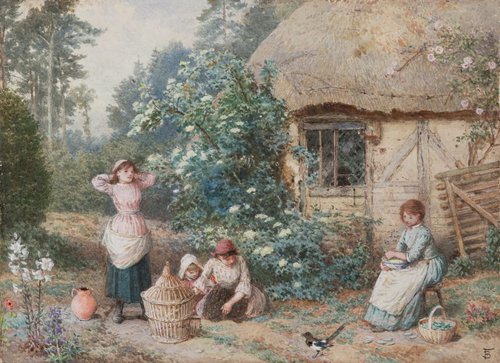Myles Birket Foster
England
Born: North shields, Northumberland, England 04 Feb 1825
Died: Weybridge, Surrey, England 27 Mar 1899
Biography
Myles Birket Foster’s formation as an apprentice to a wood engraver influenced his watercolour style, which is characterised by minutely stippled brushstrokes and abundant use of bodycolour. This is especially evident in small-scale detailed works like The magpie.
In 1858 he determined to give up a successful career as a book illustrator and concentrate entirely on watercolour painting, becoming a regular exhibitor with the Society of Painters in Water Colours.
Inspired by the Surrey countryside, Birket Foster’s watercolours were often painted on an uncommonly large scale for the medium, and combined carefully modelled figures and intricately worked details with broadly washed skies and backgrounds.
By the first half of the 20th century, when Victorian painting had fallen from fashion, Martin Hardie, writing in his comprehensive study Watercolour painting in Britain, could admit of Birket Foster’s art: ‘under all the rather sugary surface of sentiment and prettiness lies a hard core of sound and honest craftsmanship.’
Nevertheless, Birket Foster was quick to achieve considerable patronage and wealth. In 1863 he built a fine residence in Witley, Surrey, called The Hill, which was decorated by William Morris and Edward Burne-Jones. The latter’s painting, The fight: St George kills the dragon VI 1866, commissioned for the dining room at The Hill as part of a series depicting the legend of St George, is now in the Art Gallery of NSW collection.
In 1883, Birket Foster was commissioned by the trustees of the Gallery to produce a watercolour – Barking, springtime – however the artist’s engagement on other projects meant that work on the picture was not begun until at least 1884 or 1885. When it finally arrived in 1887, the watercolour was immediately written up in the press as ranking amongst Birket Foster’s ‘best efforts’. ‘It is homely, but subtle and intensely realistic’, remarked The Sydney Morning Herald art critic. ‘Without going into the details, which give rather the spirit and splendour of a softly-toned landscape than the prose of nature, it may be truly said that the work is an admirable illustration of the genius and technical skill of the artist.’
Adapted from Victorian watercolours, Art Gallery of New South Wales, Sydney, 2017

